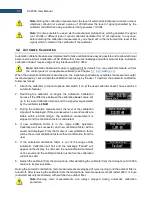
43
SV 200A User Manual
o
set the
Level
of the calibration signal, according to the used
calibrator, by pressing the
key on the
Level
position,
changing the level with the
or
key and confirming
made changes with the
key,
o
and perform calibration measurement by pressing the
key (considering that the sound calibrator is attached!).
During the calibration measurement, the level of the
calibration signal will be displayed.
After the calibration measurement, the new calibration factor should be
confirmed (
Yes
) by the
key or rejected (
No
) by the
key.
•
Position
Auto Cal.
opens a screen in which you can change the level
of the calibrator signal and switch
On
or
Off
the auto calibration
function. If Auto Calibration is switched on the calibration
measurement will start automatically after the instrument detects the
stable noise level, equal to the defined in the
Level
position
±5dB.
Measurement
section contains positions:
•
General Settings
,
which
enables
setting
of the
general
measurement parameters: measurement
Start Delay
(the delay
after pressing the
key and the measurement real start),
Integration Period
, number of measurement
Repetition Cycles
(if
Infinite
is selected the measurements will be repeated until the
key will be pressed) and type of the
LEQ Integration
(
Linear
or
Exponential
).
•
Profiles
, which enables setting for each measurement profile input
Filter
and exponential LEQ
Detector
time constant.
o
Filter
can be
A
,
C
(type 1 according to IEC 651 and
IEC 61672-1:2013),
B
(type 1 according to IEC 651) or
Z
(type 1 according to IEC 61672-1:2013),
o
Detector
type can be:
Impulse
,
Fast
or
Slow
.
•
Spectrum
, which enables setting of:
o
weighting filter for the 1/1 Octave and 1/3 Octave analysis:
Z
,
A
,
C
or
B
,
o
Detector
type:
Linear
,
Fast
or
Slow
.






























